Providing Best Services in Huntsville, AL
Providing Best Landscaping Services in Huntsville, AL

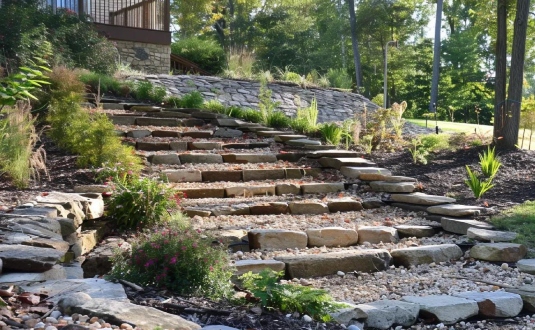

.webp)
Best Plants for Erosion Control on Sloped Yards
The best plants for erosion control on sloped yards are groundcovers, deep-rooted grasses, and hardy shrubs. Creeping juniper, pachysandra, and vinca minor spread quickly to hold soil. Native grasses like switchgrass and fescue stabilize slopes with deep roots. Shrubs such as forsythia or cotoneaster add structure while preventing runoff.
What Causes Erosion on Sloped Yards?
Erosion happens when water moves soil particles downhill during rain events. Gravity helps water flow faster on slopes, picking up dirt and carrying it away from your property.
USDA research shows erosion has decreased by 45% on farms since 1982. Home landscapes still face serious soil loss problems on unprotected slopes.
Understanding the Erosion Process
Slopes lose soil faster than flat ground because water moves faster downhill and gravity pulls loose soil particles away. Rain hits bare soil and creates small channels that grow into gullies over time. This process damages landscapes and can threaten home foundations.
Each year, unprotected slopes lose topsoil that took hundreds of years to form. The Natural Resources Conservation Service reports that it takes 500 years to form just one inch of topsoil naturally. Once gone, this valuable resource cannot be quickly replaced.
Climate Factors in Alabama
Water erosion becomes worse during Alabama's heavy spring rains and summer thunderstorms. Clay soils common in North Alabama become slippery when wet, making slopes even more unstable. Sandy soils drain too quickly, leaving plant roots without moisture support during dry periods.
Wind erosion also affects exposed slopes during dry winter months. Without protective plant cover, loose soil particles blow away and settle in unwanted areas like walkways and neighboring properties.
How Do Plants Prevent Soil Erosion?
Plants prevent erosion by anchoring soil with roots and slowing water flow with leaves. Deep root systems create underground networks that hold soil particles together.
Plant erosion control works through three mechanisms. Root systems bind soil particles together like natural cement. Leaf canopies catch raindrops before they hit the ground with full force. Plant stems slow surface water flow, giving soil time to absorb moisture.
Root System Benefits
Native grasses develop roots 6-15 feet deep. These extensive root networks create natural barriers that water cannot penetrate or remove. Prairie plants like switchgrass and little bluestem evolved these deep roots to survive droughts and hold prairie soils in place.
Ground cover plants create living carpets that protect soil surface from direct raindrop impact. Each raindrop hits soil with surprising force, but plant leaves absorb this energy harmlessly. Dense ground covers also reduce wind speed at ground level, preventing wind erosion during dry periods.
Above-Ground Protection
Trees and shrubs provide additional protection through their extensive lateral root systems. These roots spread horizontally, creating underground nets that catch and hold soil particles before they can wash away. Woody plants also create windbreaks that protect smaller plants and reduce overall erosion pressure.
Plant canopies intercept rainfall and allow it to drip slowly to the ground rather than hitting with destructive force. This gentle water delivery helps soil absorb moisture instead of creating surface runoff that carries away valuable topsoil.
What Slope Conditions Need Specific Plants?
Slope steepness determines which plants will work for erosion control. Gentle slopes need different solutions than steep hillsides.
Slope measurements help determine plant choices. Gentle slopes rise 1 foot per 3 feet across, creating a 33% grade. Steep slopes rise more than 1 foot per 2 feet across, creating grades over 50%.
Measuring Your Slope
Professional landscape architects use specialized equipment to measure exact slope percentages. You can estimate slope by measuring vertical rise over horizontal distance, then dividing rise by run and multiplying by 100 for percentage.
Slopes over 50% grade may need professional yard erosion solutions that include retaining walls or terracing. These engineered solutions work with plants to create stable landscapes.
Sunlight and Moisture Considerations
Sunlight conditions affect plant selection significantly. Full sun areas receive 6+ hours of direct sunlight daily and can support sun-loving grasses and flowers. Partial shade areas get 3-6 hours of direct sunlight and need plants that tolerate mixed conditions. Full shade areas receive less than 3 hours of direct sunlight and require shade-adapted species.
Soil moisture levels also determine plant success. Some slopes dry out quickly after rain, while others stay soggy for days. North-facing slopes stay cooler and moister than south-facing slopes in Alabama's climate. Understanding these microclimates helps match plants to conditions.
Which Ground Cover Plants Work Best for Slopes?
Liriope and creeping phlox provide excellent ground cover for sloped areas. These plants spread wide and create dense root systems that stabilize soil.
Liriope (Big Blue Lilyturf)
Liriope forms thick clumps of grass-like leaves that stay green year-round. This plant handles Alabama heat and humidity with minimal care. Dense root systems hold soil tight while leaves catch rainwater before it can cause erosion damage.
Plant liriope 12-18 inches apart for complete coverage in two growing seasons. This closer spacing prevents soil exposure between plants during establishment. Liriope grows best in sunny to partially shady slopes with average garden soil.
Creeping Phlox
Creeping phlox produces spectacular spring flower displays in pink, purple, white, and red colors. Plants grow under 6 inches tall with spreading roots that prevent soil movement effectively. This low-growing habit makes creeping phlox perfect for slopes where taller plants might block views or create maintenance problems.
Plants spread naturally through creeping stems that root at nodes, creating ever-expanding mats of coverage. Flowers appear in dense clusters that completely cover the foliage during peak bloom periods in early spring.
Shade-Tolerant Ground Covers
Japanese pachysandra creates evergreen carpets in shady areas where grass struggles to grow. Plants spread through underground stems called rhizomes and form thick mats that block water penetration. Pachysandra works especially well under trees or on north-facing slopes that receive limited direct sunlight.
Wild ginger provides another excellent shade ground cover option. Heart-shaped leaves create attractive patterns while spreading roots stabilize soil effectively. Wild ginger produces interesting brown flowers close to the ground in spring, adding subtle beauty to shaded slopes.
Which Native Grasses Stop Erosion Best?
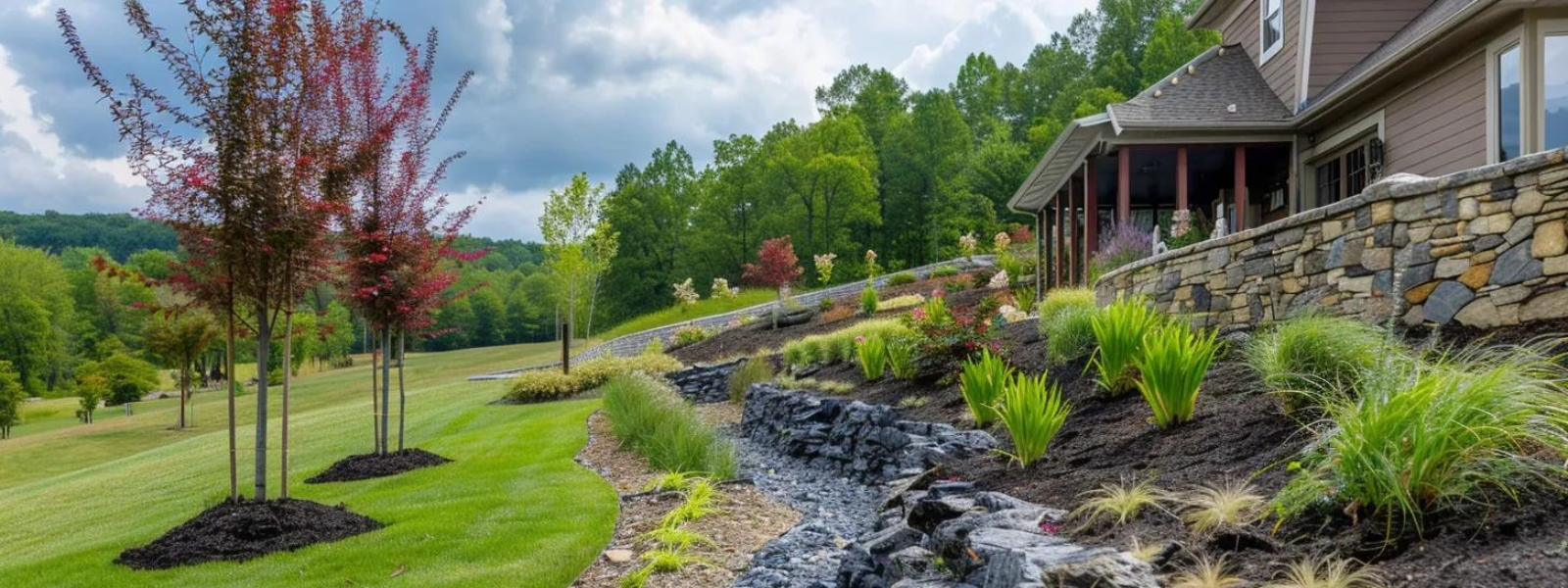
Little bluestem and switchgrass provide the deepest root systems for erosion control. Native grasses develop extensive underground networks that stabilize soil during heavy storms.
Little Bluestem
Little bluestem grows in attractive clumps that turn bronze-orange in fall and winter. This Alabama native develops roots up to 8 feet deep, creating incredible soil-holding power. Plants handle drought conditions well once established, making them perfect for sunny slopes with poor soil.
Little bluestem reaches 2-4 feet tall at maturity and requires no fertilizer or supplemental watering after the first year. Seeds provide food for birds while dried stems add winter interest to landscapes. This grass works especially well on slopes with sandy or clay soils that other plants cannot tolerate.
Switchgrass
Switchgrass creates tall, elegant stands with roots reaching 12 feet deep. This prairie native provides dramatic height and texture on large slopes that need visual impact. Plants develop into substantial clumps that can spread 3-4 feet wide over time.
Switchgrass produces airy flower panicles in late summer that add movement and texture to landscapes. Seeds feed birds while dried stems provide winter habitat for beneficial insects. This grass tolerates various soil types and moisture conditions.
Sedges and Rush Plants
Native sedges offer grass-like appearance with better tolerance for wet conditions. These plants handle slopes that stay moist after rain better than true grasses. Appalachian sedge grows well in shaded areas, while Pennsylvania sedge thrives in sunny locations.
Sedges develop fibrous root systems that create dense mats just below soil surface. These root mats act like natural erosion barriers, catching soil particles before they can wash away. Many sedge species also provide seeds that feed birds and small wildlife.
What Shrubs Provide Slope Erosion Control?
Forsythia and red-osier dogwood offer excellent shrub options for slope stabilization. These plants develop extensive root systems while providing visual interest throughout the year.
Spring-Flowering Shrubs
Forsythia produces bright yellow flowers in early spring before leaves appear. Plants spread 6-8 feet wide at maturity with dense, fibrous roots that spread in all directions to anchor soil. This fast-growing shrub tolerates poor soil conditions and requires minimal maintenance once established.
Forsythia works especially well on slopes that need quick coverage and seasonal color. Plants can handle both full sun and partial shade conditions while tolerating drought once established.
Native Woody Plants
Red-osier dogwood grows well in wet areas and produces bright red stems that provide winter color. Plants spread through underground runners to form natural colonies that cover large areas effectively. Small white flowers attract pollinators in summer, while berries feed birds in fall.
This native shrub works especially well on slopes near drainage solutions where excess water creates challenging growing conditions. Red-osier dogwood actually prefers moist soil and can handle periodic flooding without damage.
Low-Growing Shrub Options
Cotoneaster species produce small white flowers followed by colorful berries that birds enjoy. Bearberry cotoneaster stays 1-2 feet tall while spreading 6 feet wide, making it perfect for lower slopes. Rock spray cotoneaster reaches 2-3 feet tall and spreads 6-8 feet wide for larger areas.
These shrubs have a useful trait where branches root when they touch soil. This creates additional anchoring points that strengthen erosion control over time. Cotoneaster species also tolerate drought well once established, reducing maintenance requirements.
American beautyberry provides another excellent native shrub option. Plants produce clusters of bright purple berries in fall that create stunning visual displays. This shrub grows 4-6 feet tall and wide, making it suitable for naturalizing large slope areas.
Which Flowering Plants Prevent Erosion?
Daylilies and black-eyed Susans combine beauty with effective erosion control. These perennials develop strong root systems while providing seasonal color that enhances landscape appeal.
Long-Blooming Perennials
Daylilies produce trumpet-shaped flowers in dozens of colors and bloom patterns. Different varieties bloom from spring through fall, providing extended color seasons. Thick, fleshy roots create dense networks that anchor soil particles effectively while storing moisture for drought tolerance.
Each daylily clump expands over time, filling in gaps and providing better erosion control as plants mature. These perennials require virtually no maintenance once established and can thrive in various soil conditions. Daylilies work well on slopes that receive morning sun and afternoon shade.
Native Wildflowers
Black-eyed Susans bloom for months with bright yellow flowers that attract butterflies and beneficial insects. Deep taproots anchor soil while spreading growth habit fills bare spots naturally. This native wildflower self-seeds to expand coverage without additional planting.
Purple coneflower develops 4-6 foot deep taproots that create excellent soil anchoring. Plants form expanding clumps that provide better coverage each year. Strong stems resist wind and rain damage while seed heads feed goldfinches and other birds through winter.
Spreading Perennials
Wild bergamot offers another native perennial option with lavender-pink flowers that bloom through summer. Plants spread through underground rhizomes to form colonies that provide extensive erosion control. This mint family member also attracts hummingbirds and butterflies to sloped gardens.
Coral bells produce delicate flower spikes above attractive foliage that varies from green to deep burgundy depending on variety. These perennials handle partial shade well and create effective ground-level erosion control while adding subtle color to landscapes.
Do Ferns Work for Shaded Slope Erosion Control?
Christmas fern and ostrich fern provide excellent erosion control in shaded areas. Fern rhizomes spread underground to create natural erosion barriers that work effectively in low-light conditions.
Evergreen Fern Options
Christmas fern stays green all winter, providing year-round erosion protection when other plants go dormant. Plants grow 1-2 feet tall and form colonies through slowly spreading rhizomes. This native fern thrives in rich, moist soil under trees where few other plants can compete successfully.
Southern shield fern provides another evergreen option that handles Alabama's climate well. This native species develops substantial clumps that create effective erosion barriers while requiring virtually no maintenance once established.
Deciduous Fern Varieties
Ostrich fern creates dramatic 3-4 foot tall stands on moist, shady slopes. Plants spread quickly through runners to cover large areas within a few growing seasons. These ferns work especially well in areas that stay moist most of the year.
Royal fern provides another excellent option for wet, shaded slopes. This native fern develops substantial clumps that create effective erosion barriers. Golden-brown fertile fronds add interesting texture and color variation to fern plantings.
Ferns require little maintenance beyond occasional removal of old fronds in spring. These ancient plants evolved to thrive in forest conditions and rarely need fertilizer or supplemental watering once established in appropriate sites.
Which Trees Work for Major Slope Stabilization?
Eastern red cedar and American beautyberry provide large-scale erosion control for extensive slope areas. These plants develop substantial root systems that stabilize big slopes effectively.
Evergreen Tree Options
Eastern red cedar grows fast with deep taproots and extensive spreading lateral roots. Plants handle tough conditions including drought, poor soil, and wind exposure. This native evergreen provides 40-50 feet of mature height with year-round erosion protection.
Red cedar works especially well for large slopes that need quick coverage and long-term stability. Plants require no maintenance once established and provide wildlife habitat for birds and small mammals. Dense evergreen foliage creates effective windbreaks that protect smaller slope plants.
Deciduous Tree Choices
Redbud trees offer spring flowering beauty combined with effective erosion control. Heart-shaped leaves create dense shade while extensive root systems stabilize soil. These native trees grow well in various soil conditions and provide early spring color before most other plants leaf out.
River birch handles wet conditions well and provides attractive exfoliating bark for year-round interest. These fast-growing trees develop extensive root systems that excel at erosion control in moist areas.
How Should You Plant for Erosion Control Success?
Plant closer together than normal spacing for faster erosion control coverage. Dense planting prevents soil exposure between plants during the critical establishment period.
Soil Preparation Methods
Soil preparation makes the difference between success and failure. Clay soils need organic matter added to improve drainage and root penetration. Sandy soils benefit from compost or other organic amendments that help retain moisture and nutrients.
Consider soil amendment and repair services for slopes with severe erosion damage or extremely poor soil conditions. Professional soil testing can identify specific nutrient deficiencies or pH problems that affect plant establishment.
Optimal Planting Times
Plant timing affects success rates significantly. Spring planting from March through May gives plants time to establish before summer heat stress. Fall planting from September through November allows root development during cooler weather before winter dormancy.
Summer planting requires extra attention to watering and may result in higher plant mortality rates. Winter planting works for dormant woody plants but should be avoided for actively growing perennials and grasses.
Proper Spacing Techniques
Use closer spacing than normal recommendations to speed erosion control coverage. Ground covers should be planted 8-12 inches apart instead of standard 12-18 inch spacing. Shrubs work better at 3-4 feet apart rather than typical 5-6 foot spacing.
Mulching around new plants provides multiple benefits. Organic mulch prevents weeds from competing with new plants while retaining soil moisture. Mulch also prevents soil crusting and provides slow-release nutrients as it decomposes.
What Maintenance Do Erosion Control Plants Need?
First-year watering and weed control are the main maintenance requirements. Established plants need minimal ongoing care once root systems develop fully.
First-Year Care Requirements
New plantings need regular attention during their first growing season. Water deeply once weekly if rainfall totals less than 1 inch. Deep watering encourages root development better than frequent shallow watering. Remove competing weeds that steal nutrients and moisture from establishing plants.
Protecting new plants from erosion during establishment prevents failure. Use erosion control blankets on steep slopes to hold soil while plant roots develop. These biodegradable materials break down naturally as plants mature and provide their own erosion protection.
Long-Term Maintenance Tasks
Long-term maintenance requirements stay minimal for most erosion control plants. Ornamental grasses need cutting back once yearly in late winter before new growth begins. Ground covers may need edge trimming to maintain boundaries and prevent spreading into unwanted areas.
Established native plants rarely need fertilizer or supplemental watering. These plants evolved to thrive in local conditions and actually perform better without excessive care. Over-fertilizing can cause rapid growth that reduces drought tolerance and erosion control effectiveness.
What Mistakes Should You Avoid?
Planting too far apart and choosing wrong plants for conditions cause most erosion control failures. Match plants carefully to your specific site conditions for best results.
Common Planting Errors
Spacing plants too far apart leaves soil exposed between them during the critical establishment period. This defeats erosion control purposes and allows continued soil loss while plants slowly fill in gaps. Use dense spacing even if it costs more initially.
Choosing sun plants for shady conditions or drainage-sensitive plants for wet areas leads to plant death and continued erosion problems. Observe your slope carefully through different seasons to understand light and moisture patterns before selecting plants.
Maintenance Mistakes to Avoid
Skipping mulch around new plants allows weeds to compete and soil to dry out quickly. Organic mulch provides multiple benefits that improve plant establishment success rates significantly. Apply 2-3 inches of shredded hardwood mulch or similar organic material around all new plantings.
Expecting instant results leads to disappointment and premature plant replacement. Most erosion control plants need 1-2 growing seasons to provide significant soil protection. Plan accordingly and protect slopes during establishment with temporary measures if needed.
When Do You Need Professional Help?
Slopes steeper than 50% or active gullies require professional erosion control solutions. Some problems need engineering solutions beyond plant materials alone.
Signs You Need Professional Assistance
Active erosion with flowing water channels needs immediate attention to prevent further damage. Professional landscaping installation can combine terracing, retaining walls, and drainage systems with appropriate plants.
Foundation proximity makes slope stability critical for home protection. Slopes within 10 feet of house foundations need professional evaluation to prevent structural damage. Improper drainage can cause foundation settlement or basement flooding during heavy rains.
Project Scale Considerations
Large slope areas over 1000 square feet often benefit from professional design and installation. Professionals can specify appropriate plant combinations and installation techniques that ensure success. They also understand local soil conditions and climate factors that affect plant selection.
Complex sites with multiple microclimates, existing utilities, or special access requirements typically need professional expertise to develop effective solutions that work long-term.
How Do You Combine Plants for Best Results?
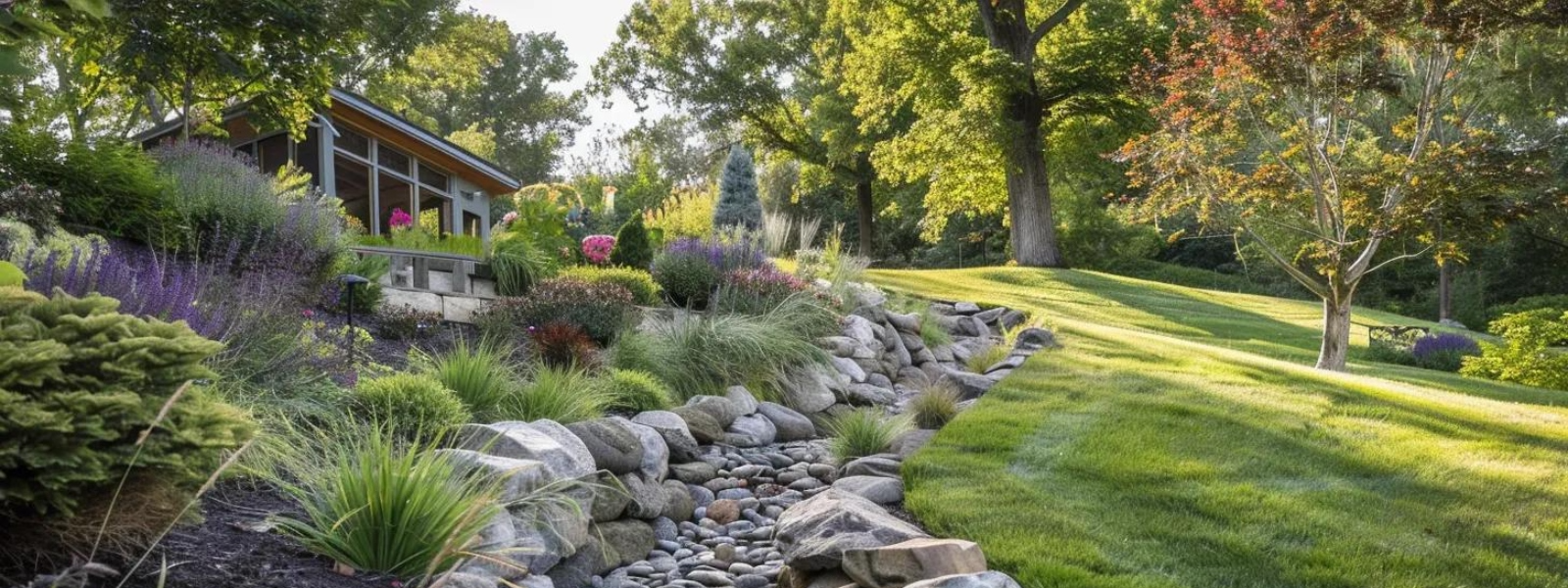
Layered planting with different plant types provides the most effective erosion control. Mix grasses, perennials, and ground covers for complete coverage at different levels.
Sunny Slope Plant Combinations
Sunny slope combinations work well with native grasses as the backbone planting. Little bluestem and switchgrass provide deep-rooted stability while flowering perennials like black-eyed Susan and purple coneflower add color and attract wildlife.
Add ground covers like creeping phlox or wild bergamot to fill spaces between larger plants. This layered approach provides erosion protection at soil level while taller plants handle wind and major water flow. Professional landscaping design can help create effective plant combinations for your specific site.
Shaded Slope Plant Combinations
Shady slope combinations rely on ferns and shade-adapted ground covers for primary erosion control. Christmas fern and ostrich fern provide structural stability while pachysandra or wild ginger creates dense ground-level coverage.
Include native shrubs like red-osier dogwood or American beautyberry for areas needing height and wildlife value. These woody plants provide long-term stability as they mature into substantial erosion barriers.
What Specific Plants Work Best in Alabama?
Alabama's climate supports many native plants that provide excellent erosion control while requiring minimal maintenance. These plants evolved in local conditions and handle heat, humidity, and variable rainfall patterns naturally.
Native Grass Options for Alabama
River oats create beautiful ornamental grass displays while providing effective erosion control. This native grass develops extensive root systems and handles both sun and partial shade conditions. Attractive seed heads provide winter interest and bird food.
Indiangrass provides another excellent native option with deep roots and attractive fall color. Plants reach 4-6 feet tall and develop extensive clumping root systems that anchor soil effectively.
Alabama Native Vines and Climbers
Coral honeysuckle offers native vine coverage for steep slopes or areas needing quick establishment. Unlike invasive honeysuckle species, this native plant grows moderately and provides red tubular flowers that hummingbirds love. Plants work especially well combined with other erosion control species.
Cross vine provides another native climbing option with orange trumpet flowers and evergreen foliage. This vigorous vine can quickly cover slopes while developing strong anchor roots.
Native Ferns for Alabama Conditions
Southern shield fern thrives in Alabama's humid conditions and provides evergreen coverage in shaded areas. This native fern develops substantial clumps that create effective erosion barriers while requiring virtually no maintenance once established.
Choosing plants adapted to Alabama conditions increases success rates while reducing maintenance requirements. These plants handle local weather patterns and soil types better than non-native alternatives. Low-maintenance plants for Alabama provide additional options for specific site conditions.
How Does Erosion Control Improve Property Value?
Effective erosion control protects existing landscape investments while preventing costly damage repairs. Stable slopes maintain their appearance and function throughout weather extremes.
Property Value Benefits
Property buyers notice well-maintained slopes that show no signs of erosion damage. Professional-looking erosion control increases curb appeal and demonstrates proper landscape management. This attention to detail suggests overall property care that buyers value.
Preventing erosion damage costs less than repairing it after problems develop. Replacing washed-away topsoil, fixing drainage issues, and replanting failed areas requires significant expense. Investing in proper erosion control prevents these future costs.
Insurance and Risk Reduction
Insurance companies may offer lower premiums for properties with proper erosion and drainage management. Stable slopes reduce risks of foundation damage, basement flooding, and other water-related problems that generate expensive claims.
Professional landscaping installation that includes proper erosion control demonstrates commitment to property maintenance that benefits both current enjoyment and future resale value.
Frequently Asked Questions
How Long Does It Take for Plants to Stop Erosion?
Most erosion control plants need 1-2 growing seasons to provide effective soil protection. Ground covers like liriope establish faster than trees and shrubs, often showing results within 6-12 months.
What Is the Best Plant for Steep Slopes?
Native grasses like little bluestem and switchgrass work best for steep slopes because they develop roots 6-12 feet deep. These deep root systems provide superior soil anchoring on challenging grades.
Do Erosion Control Plants Need Special Soil?
Most erosion control plants adapt to various soil types, but proper drainage prevents root rot. Clay soils benefit from organic matter additions, while sandy soils need amendments to retain moisture.
Can You Plant on a 45 Degree Slope?
A 45-degree slope equals 100% grade, which requires professional evaluation. Most plant-only solutions work best on slopes under 50% grade. Steeper slopes need engineering solutions combined with plants.
What Plants Work in Full Shade on Slopes?
Christmas fern, ostrich fern, pachysandra, and wild ginger provide excellent erosion control in full shade conditions. These plants thrive under tree canopies where most other species struggle.
Conclusion
Plants can stop erosion on sloped yards when you choose appropriate species for your specific conditions. Start with fast-growing ground covers and native grasses that provide immediate soil protection. Add flowering perennials for seasonal color and shrubs for long-term structural stability.
Success requires matching plants to site conditions, using proper spacing, and providing adequate care during establishment. Within two growing seasons, you'll have attractive slopes that resist erosion while enhancing your landscape's beauty and value.
Professional help ensures optimal plant selection and installation techniques for challenging sites. Consider consulting experts for slopes over 50% grade or areas with active erosion problems that need immediate attention.
Stay Connected and Inspired
Get the latest landscaping tips, seasonal care guides, and exclusive offers delivered straight to your inbox. Don’t miss out on expert advice and ideas to transform your outdoor spaces.
Sign Up for Our Newsletter Today!


Your Next Idea Awaits
Stay inspired with our latest landscaping tips and trends.
.webp)
.webp)

.webp)
.webp)
.webp)
.webp)
.webp)

.webp)



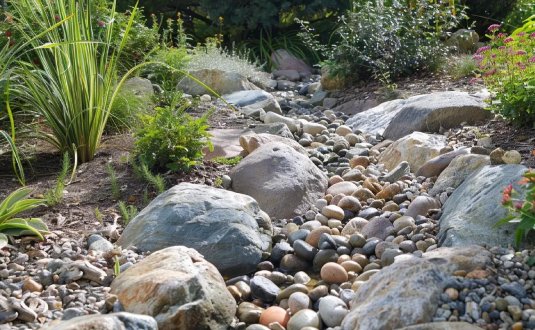

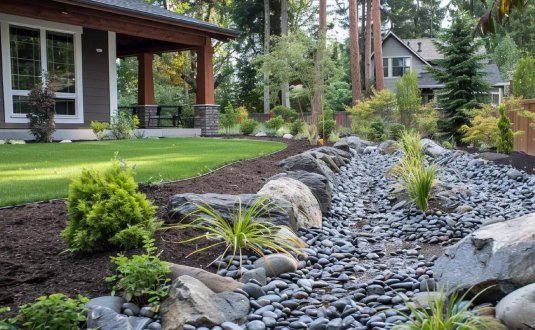
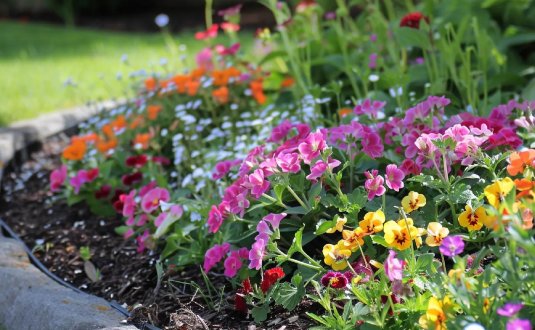

.webp)
.webp)





